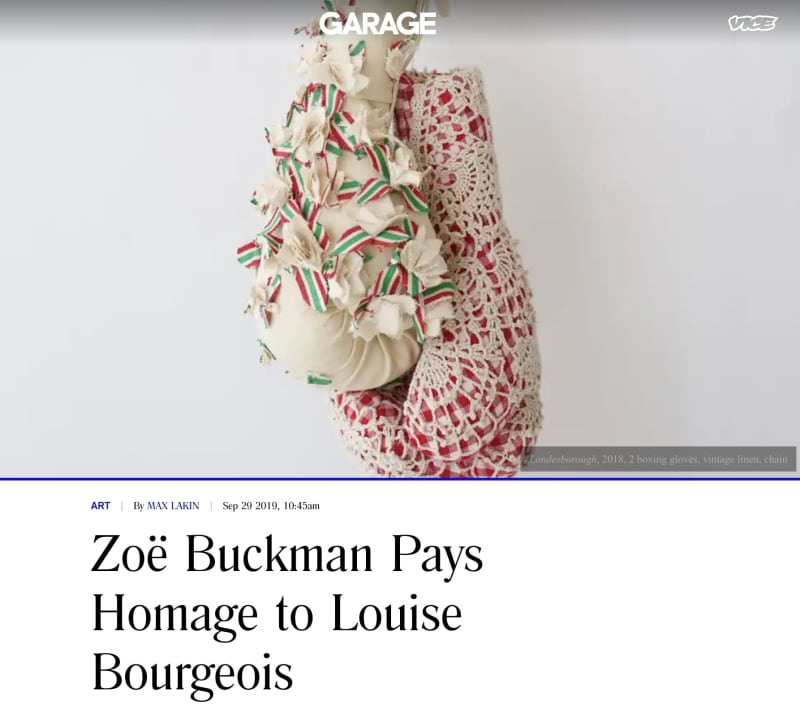In her current show at Fort Gansevoort, the artist explores grief through her work, giving a nod to feminist forebears in the process.
Buckman, who had taken up boxing a few years ago, was drawn to incorporate in her practice that sport’s psychic dichotomy, the way boxing gloves are meant to protect their wearer but harm whomever gets in their way. She had made versions bound in second-hand wedding dresses, a curdled commentary on the retrograde aspects of marriage, but “Heavy Rag” is a more robust collision—the traditionally masculine purview of fist-fighting with the durable conception of craft and domestic work as feminine spaces—the hard and the soft, to clothe the body and to obliterate it.
“Heavy Rag” is an expansion of, and shares a name with, a sparer show of work Buckman presented at Albertz Benda last year. There, a pair of gloves and a punching bag were accompanied by separate audio recordings of the artist’s training sessions and her giving birth, which would synch and blend into each other so that it became difficult to parse which moment of physical strain you were hearing. In this latest iteration, the sculptures have metastasized. Clusters of gloves rigged to the ceiling by chain link float eerily in space like carcasses awaiting butchering. They’re soft to the touch but pack a wallop. Though they’re relieved from their fists and muffled in lace and exaggerated gingham bows and sunny florals, they retain the kinetic violence of their design. Would men be less eager to pummel each other’s orbital bones into pulp if they had to wear delicate crochet to do so? Perhaps, but it would still hurt.
Between the cluster works are pairs of gloves linked at the fingers, a poetically ambiguous duet, depending on your mood, of aggression and care, or of finding a hand in the dark and the fear of it being gone. Like Bourgeois’s Poids, a perfectly weighted cantilevered assembly of glass orbs, or the soft sculptures of bodily forms fused together, Buckman’s gloves suggest a body suspended precariously in place, a fragile moment seized in time. Buckman said she and her family coped with her mother’s cancer for nine years, a period in which her heath “was always in the balance.”
Just as Bourgeois used stained tablecloths and napkins, so too has Buckman appropriated vintage tea towels, which she embroidered with alternatingly lyrical and koanic free verse: come-ons and dismissals from a former boyfriend in sing-songy East London diction, Yiddish comforts from her grandmother, lines from her mother’s writing, snatched bits of conversation spliced from their context so that they can sound menacing, or worse (“Start off super light / then it builds” could refer to any number of things: the menstrual cycle, physical abuse, a garden variety migraine; in fact it’s a suggestion from an S&M handbook). Some of these are arranged artfully, hand-embroidered in cursive that fans out like a sunburst (“I was thirteen / and three quarters / and ‘a big girl, kein a hora!’ / according to / grandma”), others are machine-embroidered in blunt block text (“I told him I could get blood out of anything”). Often both styles will work in tandem, an emphasis of emotion over syntax, as in “If I Had A Penny,” which reads “He said, BABY YOU AIN’T got NOTHING to worry about.” “Which was a lie,” Buckman clarified, “because I had a lot to worry about.”
The embroidery in “Heavy Rag” (some of which Buckman completed over flights from New York, where she lives, to London to be with her family) function as both catharsis and homage, both of her mother but also the past versions of herself. They court ache, pinpoint the moment the bruise hardens into a callus, and present the callus as memento. Some of the towels are adorned by stains, souvenirs of their own past lives, and Buckman has embroidered around them so they become pronounced, like archipelagos, the small moments that chain together and become a life. These are portraits, after a fashion. Strands of memory plucked and recast, taut and tender but also slightly soured, all the devastations, disappointments and traumas, but also warmth, affection and joy.
If you’re English, which Buckman is, the tea towel is a loaded signifier. A cup of tea is a formative experience, the ritual its own comfort. It’s tempting to look at the tea towel, and by extension, the kitchen and the cooking and cleaning as a proxy for “women’s work,” which would lend them a feminist tint. Buckman has trafficked in more explicitly charged imagery—neon reproductive organs, powder-coated forceps, a plasticized cast of her placenta. But tea isn’t a gendered beverage choice as it might seem in the U.S; it’s a Proustian equalizer that persists regardless of class or sex. The tea towels, which occupy the gallery’s third floor, are meant to conjure the memory of a specific place in time. For Buckman, these are powerful totems more than political stance, the banal and the personally profound given universal dimension. In her mother’s absence the tea towels remain. It’s not exclusively feminist to acknowledge one’s own mother.
It helps this vision that Fort Gansevoort retains the shape of its past life, a three story townhouse at the lower lip of the meatpacking district. A series of porcelain tea cups, arranged over a bar original to the building, appear in various states of collapse, pocked with holes or riven with gashes. These are perhaps the most affecting articulation of loss. They look like how grief feels, to be unable to hold onto something slipping away, and how to continue when there’s pieces missing. “A great day is when you’re challenged and suffering and you find some way through it,” Buckman said. “That’s part of life, and life is beautiful, isn’t it?”

